
This week, because we’ve been reflecting on who we are as learners we’ve been sharing a few books each day that feature characters who are able to reach their goals in a variety of ways. We’ve explored several different models of multiplication this week and we’ve learned some elaboration strategies for adding detail to our writing. We hope this will make our writing even more interesting.
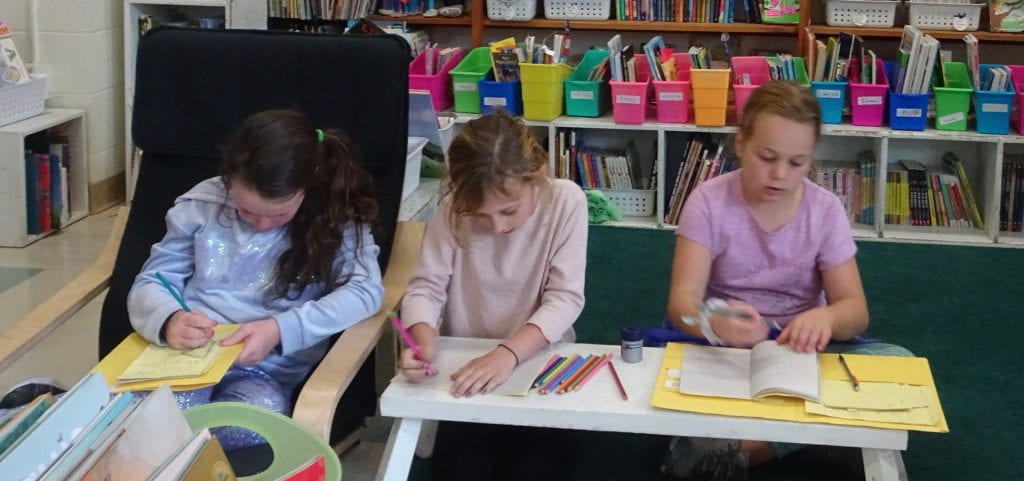
S.E.L.- Goal Setting – Preparing for Student-Led Conferences
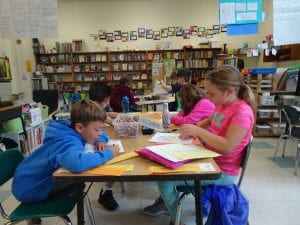 This week the children completed their multiple intelligence graphs and described what they know about themselves are learners and doers. They spent time thinking about how they might like to grow as readers. They selected books that seem “just right” at this point in the year and described them. Then they set a goal for how they would like to grow as a reader and made a plan for what they might do to meet that goal. Many of them would like to be able to read a whole series, others would like to be able to read and understand more complex chapter books, and still others would like to learn how to figure out how to read new words. They also spent some time exploring different trait of writing: ideas, organization, sentence fluency, word choice, voice and conventions. The children chose pieces of writing they feel best show their writing abilities. They described why they chose these pieces and used them as a basis for setting a next step goal. Some of them would like to be neater, others would like to spell better, and still others would like to make their audience laugh. Third graders have a unique sense of humor. Be prepared – a few of them can write with humor and still develop a story, most
This week the children completed their multiple intelligence graphs and described what they know about themselves are learners and doers. They spent time thinking about how they might like to grow as readers. They selected books that seem “just right” at this point in the year and described them. Then they set a goal for how they would like to grow as a reader and made a plan for what they might do to meet that goal. Many of them would like to be able to read a whole series, others would like to be able to read and understand more complex chapter books, and still others would like to learn how to figure out how to read new words. They also spent some time exploring different trait of writing: ideas, organization, sentence fluency, word choice, voice and conventions. The children chose pieces of writing they feel best show their writing abilities. They described why they chose these pieces and used them as a basis for setting a next step goal. Some of them would like to be neater, others would like to spell better, and still others would like to make their audience laugh. Third graders have a unique sense of humor. Be prepared – a few of them can write with humor and still develop a story, most  cannot. Finally the children looked at several of their math problems from the past month and described the strategies they are comfortable using now. Looking forward at things we’ll learn more about this year, they set goals for what they hope to be able to do as a mathematician by the end of third grade.
cannot. Finally the children looked at several of their math problems from the past month and described the strategies they are comfortable using now. Looking forward at things we’ll learn more about this year, they set goals for what they hope to be able to do as a mathematician by the end of third grade.
The children have been thoughtful and self-reflective. This is a real challenge for 8 and 9 year olds. They are developmentally just becoming able to look beyond the concrete aspects of their work and consider the work habits they can apply to be even more successful. You’ll see this when they share with you next week.
Writing Ideas
 We have begun to explore different ways to develop ideas. We know that all sentences have a doer (a noun) doing something (a verb) along with a capital letter at the start and punctuation at the end. We’ve practiced writing simple sentences. Now we are learning how to add details to our sentences by adding adjectives, and phrases that include information about when, where, how and why. We’ve worked together to expand some simple sentences to understand how the information we add helps bring deeper meaning to our writing. They children have had the chance to practice on their own as well. Some of them are beginning to use these strategies on their own. It is fun to see how they are thoughtfully adding details as they write that helps develop their plots and they characters.
We have begun to explore different ways to develop ideas. We know that all sentences have a doer (a noun) doing something (a verb) along with a capital letter at the start and punctuation at the end. We’ve practiced writing simple sentences. Now we are learning how to add details to our sentences by adding adjectives, and phrases that include information about when, where, how and why. We’ve worked together to expand some simple sentences to understand how the information we add helps bring deeper meaning to our writing. They children have had the chance to practice on their own as well. Some of them are beginning to use these strategies on their own. It is fun to see how they are thoughtfully adding details as they write that helps develop their plots and they characters.
Bits and Pieces –
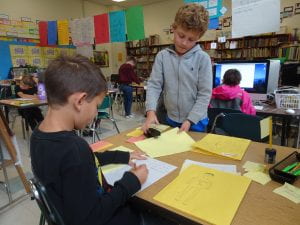 We’ve been learning how multiplication can be represented about repeated addition in a group model. We’ve also explored arrays and learning how to read them with the number of rows first and then the amount in each row next.
We’ve been learning how multiplication can be represented about repeated addition in a group model. We’ve also explored arrays and learning how to read them with the number of rows first and then the amount in each row next.- We completed School Days According to Humphrey. 3E seemed to enjoy Humphrey so we began a second book from the series, Mysteries According to Humphrey. Since we began this read-aloud many of the children have discovered the Humphrey bin and the Humphrey books in the library. It’s exciting to see their enthusiasm grow for a series, reading and a character.
- Senora Murphy is starting a mini project with the 3rd graders – My Pet –
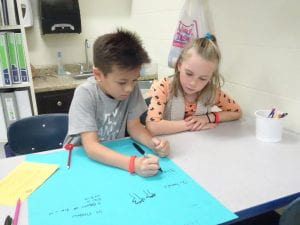 Mi Mascota. Senora Murphy is asking students and their families to send in a 4 x 6 photo of their child’s pet, or favorite animal or stuffed animal if they do not have a pet. Please send the photographs in by October 25th. If you are not able to print at home, please attach it to an email and I’ll print it out here at school.
Mi Mascota. Senora Murphy is asking students and their families to send in a 4 x 6 photo of their child’s pet, or favorite animal or stuffed animal if they do not have a pet. Please send the photographs in by October 25th. If you are not able to print at home, please attach it to an email and I’ll print it out here at school. - This week during Open Circle we talked about “the school listening look”, feelings and how body language communicates with others.
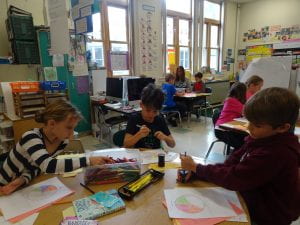
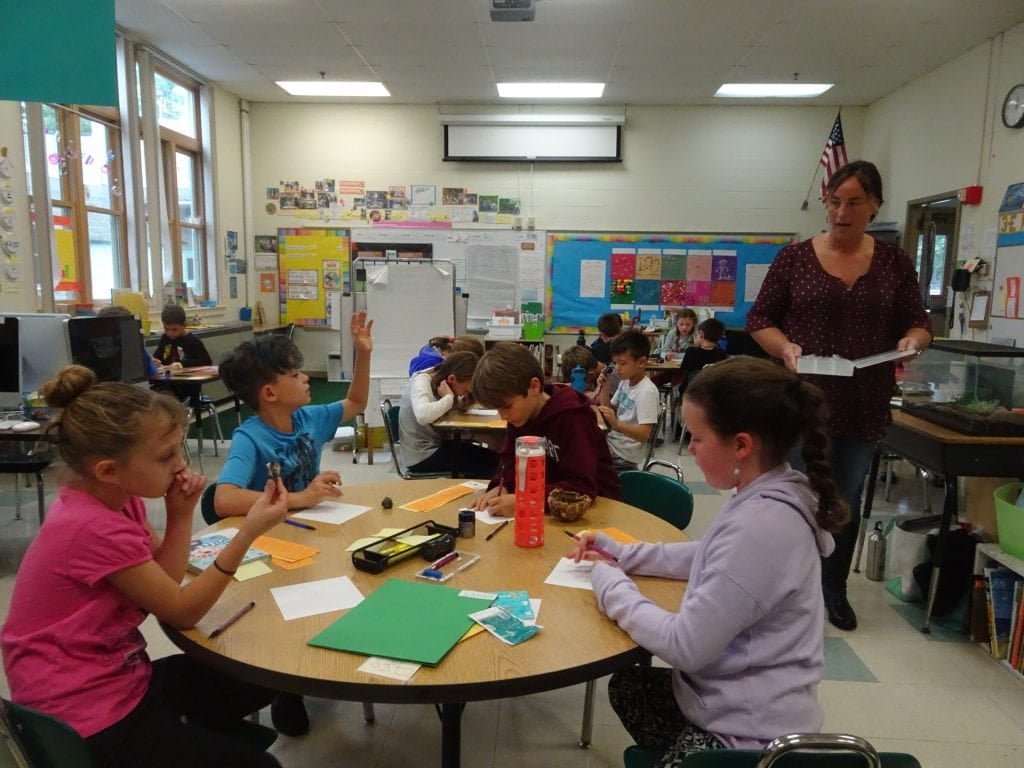 We’ve had another full week. We’ve got lots of initiatives going. We are preparing for student led conferences during the week of October 21 and that means a lot of data gathering on the children’s part to establish their starting points for the year. We’ve continued to explore MI theory and to discover how each of us is a unique combination of math, art, word, nature, music, body, people and self smart. We look forward to sharing with you at the conference. Of course we’re reading, writing, solving problems and learning how to make responsible choices so everyone can make the best use of our time learning together.
We’ve had another full week. We’ve got lots of initiatives going. We are preparing for student led conferences during the week of October 21 and that means a lot of data gathering on the children’s part to establish their starting points for the year. We’ve continued to explore MI theory and to discover how each of us is a unique combination of math, art, word, nature, music, body, people and self smart. We look forward to sharing with you at the conference. Of course we’re reading, writing, solving problems and learning how to make responsible choices so everyone can make the best use of our time learning together. This week we began to learn about how multiplication and addition are related. We’ve learned that it is repeated addition and that we use multiplication to count and find totals faster.
This week we began to learn about how multiplication and addition are related. We’ve learned that it is repeated addition and that we use multiplication to count and find totals faster.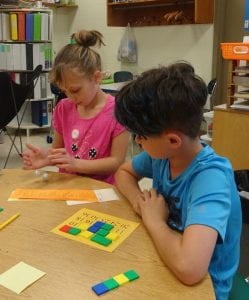 We also learned about ratios and how they define an expected relationship between to things. We discovered that’s another tool where multiplication helps. If we expect that 1 bicycle means 2 wheels, then we can also expect that 4 bicycles means 8 wheels and 12 bicycles means 24 wheels. Twos are easy to imagine because we can all count by two’s pretty easily. We created ratio charts for challenging amounts as well so we can use them to guide our future work with multiplication as we work to master the concept and learn the hundred facts.
We also learned about ratios and how they define an expected relationship between to things. We discovered that’s another tool where multiplication helps. If we expect that 1 bicycle means 2 wheels, then we can also expect that 4 bicycles means 8 wheels and 12 bicycles means 24 wheels. Twos are easy to imagine because we can all count by two’s pretty easily. We created ratio charts for challenging amounts as well so we can use them to guide our future work with multiplication as we work to master the concept and learn the hundred facts.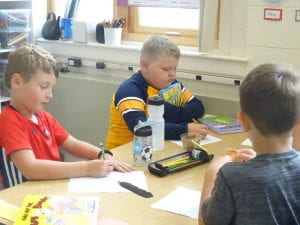 This week we began exploring the six traits that all quality pieces of writing have: ideas, organization, voice, sentence fluency, word choice and conventions. After reading about each one of the traits the children selected one or two that they would like to focus on and set goal around. And we began learning about them. We’ve begun with ideas. We are learning what it means to choose strong topics, to use interesting details and to stick to one topic so the writing is clear and understandable. We have lots of questions. Where do ideas come from? How are they developed and planned? Are ideas always in words, can they come from pictures too? How can we collect ideas?
This week we began exploring the six traits that all quality pieces of writing have: ideas, organization, voice, sentence fluency, word choice and conventions. After reading about each one of the traits the children selected one or two that they would like to focus on and set goal around. And we began learning about them. We’ve begun with ideas. We are learning what it means to choose strong topics, to use interesting details and to stick to one topic so the writing is clear and understandable. We have lots of questions. Where do ideas come from? How are they developed and planned? Are ideas always in words, can they come from pictures too? How can we collect ideas? We began my describing one object. We are able to pass it from person to person and collect 16 different descriptive words about that one small thing – it was a shell. Next the children each chose an object to describe and finally we work to draw the object as a scientist would. We watched a video call Austin’s Butterfly as a way to inspire each of us to work toward excellence by taking each project step-by-step and getting advice along the way. We hope to finish our drawing and descriptions next week
We began my describing one object. We are able to pass it from person to person and collect 16 different descriptive words about that one small thing – it was a shell. Next the children each chose an object to describe and finally we work to draw the object as a scientist would. We watched a video call Austin’s Butterfly as a way to inspire each of us to work toward excellence by taking each project step-by-step and getting advice along the way. We hope to finish our drawing and descriptions next week Our
Our  This week the children had many
This week the children had many  It has been a week of firsts: first field trip, first attempts to summarize reading, first reading response and first book club.
It has been a week of firsts: first field trip, first attempts to summarize reading, first reading response and first book club.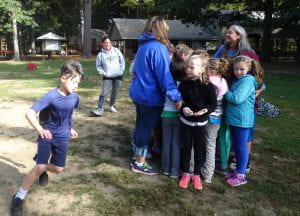 Our week began with our trip to Camp Lincoln. After a few whole grade games – The Wild Wind Blows… and Alaskan Baseball, we joined Goat for a walk to the point. Along the way we gathered ingredients for Trail Spice Tea. First we collected wintergreen leaves, next we found Indian Cucumber roots and finally we learned to identify white pine needles and added those to the mix. Once at the point we sat quietly and created a map of the sounds we could hear. After a few minutes we retuned to the circle to try our tea. It was minty and mild – not bad at all.
Our week began with our trip to Camp Lincoln. After a few whole grade games – The Wild Wind Blows… and Alaskan Baseball, we joined Goat for a walk to the point. Along the way we gathered ingredients for Trail Spice Tea. First we collected wintergreen leaves, next we found Indian Cucumber roots and finally we learned to identify white pine needles and added those to the mix. Once at the point we sat quietly and created a map of the sounds we could hear. After a few minutes we retuned to the circle to try our tea. It was minty and mild – not bad at all.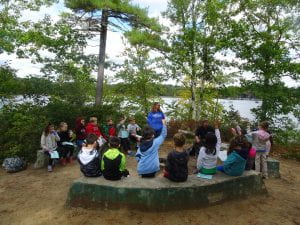 The second part of our day was a personal challenge. Each of the children had the opportunity to try climbing the high wall. Newt helped us with this element. He encouraged the children to each set a personal goal – putting on the harness and approaching the wall, going halfway, reaching the wedge. He encouraged and supported each of the children to do what felt best to him or her. It was hard and high, difficult and scary. It took strength, courage and determination. We wished we had a bit more time so that everyone had the amount of time he or she needed/wanted to achieve the goal they had set. Regardless, it was a day of learning and fun. We discovered a lot about each other.
The second part of our day was a personal challenge. Each of the children had the opportunity to try climbing the high wall. Newt helped us with this element. He encouraged the children to each set a personal goal – putting on the harness and approaching the wall, going halfway, reaching the wedge. He encouraged and supported each of the children to do what felt best to him or her. It was hard and high, difficult and scary. It took strength, courage and determination. We wished we had a bit more time so that everyone had the amount of time he or she needed/wanted to achieve the goal they had set. Regardless, it was a day of learning and fun. We discovered a lot about each other. We’re trying to develop a system for keeping track of when we are behaving responsibly. There are several people in our class who would rather talk than accept the responsibility for settling in and doing the work expected of them throughout the day. We talked about this. At first the kids suggested a 3 strikes, you’re out kind of deal with a note home for bad behavior. That didn’t feel too great, so we kept thinking. Finally through discussion, we decided that we’d look for role models throughout the day, and note them on the board. Those children who are consistently setting an example for the class will get notes sent home thanking them for their role in helping us create a calm, learning environment. We’ve been trying this for a few days … we’ll see how it goes. Ask your child how s/he feels about it and if it is reminding him/her to do the right thing at the right time more often.
We’re trying to develop a system for keeping track of when we are behaving responsibly. There are several people in our class who would rather talk than accept the responsibility for settling in and doing the work expected of them throughout the day. We talked about this. At first the kids suggested a 3 strikes, you’re out kind of deal with a note home for bad behavior. That didn’t feel too great, so we kept thinking. Finally through discussion, we decided that we’d look for role models throughout the day, and note them on the board. Those children who are consistently setting an example for the class will get notes sent home thanking them for their role in helping us create a calm, learning environment. We’ve been trying this for a few days … we’ll see how it goes. Ask your child how s/he feels about it and if it is reminding him/her to do the right thing at the right time more often.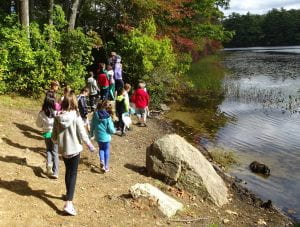 Our Open Circle lessons this week have centered on being calm and listening. We’ve been reading the I Am…books by Susan Verde. She is a yogi and her books are written to help us think about mindfulness, empathy and compassion. They are helping us to create a more peaceful, calm, and focused classroom. We are certainly more available for learning when we are calm.
Our Open Circle lessons this week have centered on being calm and listening. We’ve been reading the I Am…books by Susan Verde. She is a yogi and her books are written to help us think about mindfulness, empathy and compassion. They are helping us to create a more peaceful, calm, and focused classroom. We are certainly more available for learning when we are calm.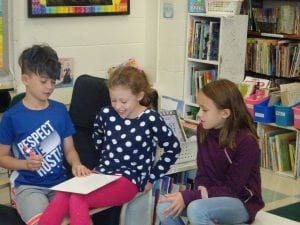 For the past few weeks, each time we’ve read a book together we’ve thought about what the author’s purpose was. What was the message he or she hoped we’d take from the story? We discovered sometime books help us feel better about our selves and our struggles because we can read that we are not the only one. We’ve discovered that some books are just entertaining – Dumb Bunnies was meant to make us laugh. Some books help us understand how others feel and still others can teach us information or history.
For the past few weeks, each time we’ve read a book together we’ve thought about what the author’s purpose was. What was the message he or she hoped we’d take from the story? We discovered sometime books help us feel better about our selves and our struggles because we can read that we are not the only one. We’ve discovered that some books are just entertaining – Dumb Bunnies was meant to make us laugh. Some books help us understand how others feel and still others can teach us information or history.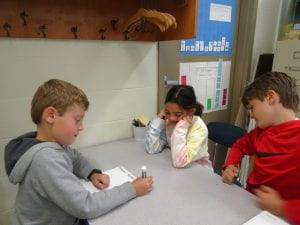 We’ve also practiced summarizing. We’ve been trying to summarize our reading in three to five sentences. That means we a trying to collect the essential ideas in the story without getting bogged down in the detail. We’ve worked together as a class, in small groups and individually to practice this week. We are using this as part of a reading response routine: Sketch-to-Stretch. This week everyone in the class is reading one of four different picture books with a theme of writing and creating stories. We’ll be meeting in book clubs next Tuesday to share our responses. Each will show images of the main actions, have a 3 to 5 sentence summary and a caption sharing the author’s purpose or message. While still in process, it is interesting to notice how each of the students is choosing to share his or her thinking. You may want to ask your child about his/her book club book.
We’ve also practiced summarizing. We’ve been trying to summarize our reading in three to five sentences. That means we a trying to collect the essential ideas in the story without getting bogged down in the detail. We’ve worked together as a class, in small groups and individually to practice this week. We are using this as part of a reading response routine: Sketch-to-Stretch. This week everyone in the class is reading one of four different picture books with a theme of writing and creating stories. We’ll be meeting in book clubs next Tuesday to share our responses. Each will show images of the main actions, have a 3 to 5 sentence summary and a caption sharing the author’s purpose or message. While still in process, it is interesting to notice how each of the students is choosing to share his or her thinking. You may want to ask your child about his/her book club book.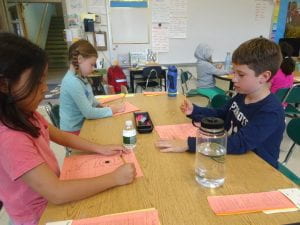 We are continuing to explore the
We are continuing to explore the 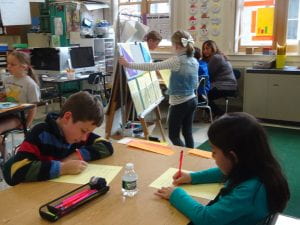 Be on the look out next week for
Be on the look out next week for 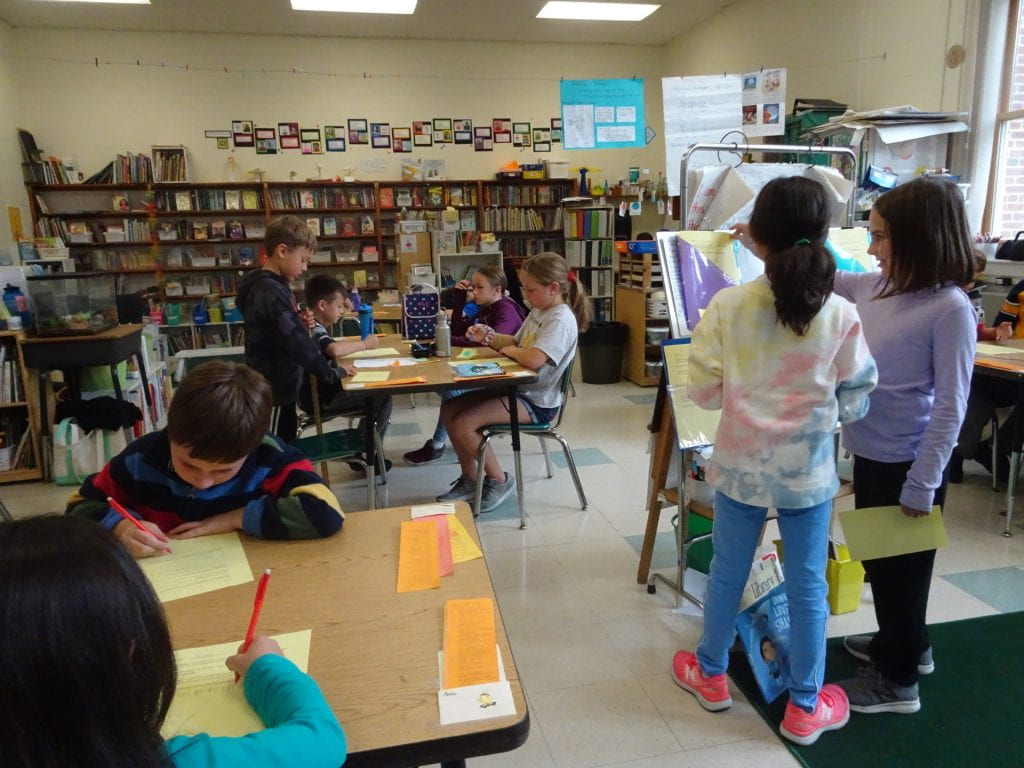
 It has been a busy, full week. We are enjoying each other, the books we share and the opportunities we have for learning together. We’re deepening our understanding of our class rules and the school expectations. What does “acting responsibly” look like and sound like? How do our choices impact others? Does that matter? What is the right thing to do?
It has been a busy, full week. We are enjoying each other, the books we share and the opportunities we have for learning together. We’re deepening our understanding of our class rules and the school expectations. What does “acting responsibly” look like and sound like? How do our choices impact others? Does that matter? What is the right thing to do?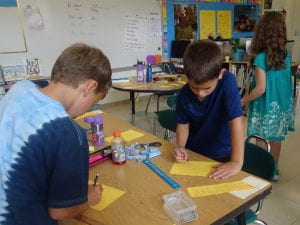 The focus of our calendar is 2-dimensional geometry. This week we learned about the three different types of angles. We made a set and labeled the angles we could find in a scavenger hunt around our classroom. Right angles were easiest to find in our classroom, acute angles were the second most common and obtuse were third and challenging to find. We learned that an angle has one end point and two rays. Later, using The Grouchy Ladybug, we explored the angles made by the hands of the clock as time changes.
The focus of our calendar is 2-dimensional geometry. This week we learned about the three different types of angles. We made a set and labeled the angles we could find in a scavenger hunt around our classroom. Right angles were easiest to find in our classroom, acute angles were the second most common and obtuse were third and challenging to find. We learned that an angle has one end point and two rays. Later, using The Grouchy Ladybug, we explored the angles made by the hands of the clock as time changes. 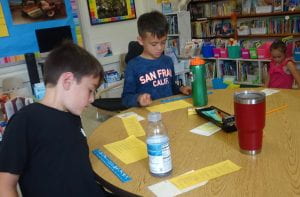 We’ve also begun learning about symmetry and congruence. We know that a shape is symmetrical when it can be cut in half so that both halves are mirror images. Through the wide variety of shapes on our calendar pattern we have learned that shapes with congruent sides and/or congruent angles are symmetrical. Some shapes have only one line of symmetry while others have many. We are also learning what congruence means. We know that a congruent shape is exactly equal in size and shape. When shapes are same in only one or the other (size or shape), they are similar but not congruent.
We’ve also begun learning about symmetry and congruence. We know that a shape is symmetrical when it can be cut in half so that both halves are mirror images. Through the wide variety of shapes on our calendar pattern we have learned that shapes with congruent sides and/or congruent angles are symmetrical. Some shapes have only one line of symmetry while others have many. We are also learning what congruence means. We know that a congruent shape is exactly equal in size and shape. When shapes are same in only one or the other (size or shape), they are similar but not congruent.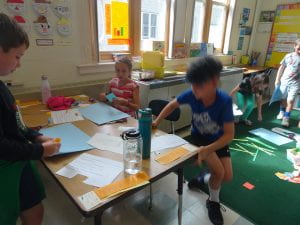 Most days our math workshop consists of Quick Images (
Most days our math workshop consists of Quick Images (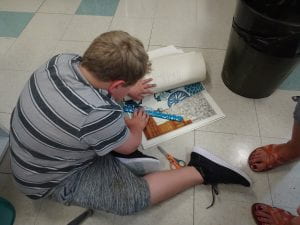 manner of the author-illustrator, Leo Lionni. Each collage has the same elements, but each student chose which item would be how many inches long or tall. Some have flowers that are 9 inches tall and other collages have 2-inch flowers. It was interesting to see children’s varying degrees of comfort with measuring and cutting and checking and revising. Some children were precise, others were okay with being close enough and still others got lost in creating and didn’t measure at all. “It was too hard to measure and do what I wanted.” Next week we’ll do some measurement activities with the metric system and learn about perimeter.
manner of the author-illustrator, Leo Lionni. Each collage has the same elements, but each student chose which item would be how many inches long or tall. Some have flowers that are 9 inches tall and other collages have 2-inch flowers. It was interesting to see children’s varying degrees of comfort with measuring and cutting and checking and revising. Some children were precise, others were okay with being close enough and still others got lost in creating and didn’t measure at all. “It was too hard to measure and do what I wanted.” Next week we’ll do some measurement activities with the metric system and learn about perimeter.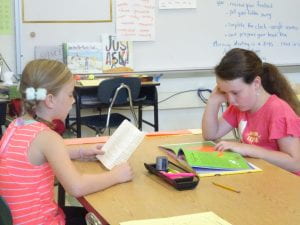 Our shared reading’s focus has been words. There are several really great books about collecting words and sharing them with the world. Each day we read one and used some aspect from the story to guide our word collections. One Monday and Tuesday we collected words that popped out at us while we were reading. We talked about syllables and looked for multisyllabic words on Wednesday. We learned about synonyms and listed a set for fabulous after reading The Boy Who Cried Fabulous. We read Punnidles(two photographs that show a punny riddle), learned about compound words. Later created our own original drawn versions. Bear + Feet = bare feet. Finally we learned about homophones with Dear Deerand began making our collection of those. Homophones add a real spelling challenge so we’ll try to keep our challenges straight.
Our shared reading’s focus has been words. There are several really great books about collecting words and sharing them with the world. Each day we read one and used some aspect from the story to guide our word collections. One Monday and Tuesday we collected words that popped out at us while we were reading. We talked about syllables and looked for multisyllabic words on Wednesday. We learned about synonyms and listed a set for fabulous after reading The Boy Who Cried Fabulous. We read Punnidles(two photographs that show a punny riddle), learned about compound words. Later created our own original drawn versions. Bear + Feet = bare feet. Finally we learned about homophones with Dear Deerand began making our collection of those. Homophones add a real spelling challenge so we’ll try to keep our challenges straight.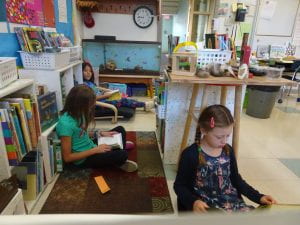 We spent some time reviewing the main parts of a sentence.
We spent some time reviewing the main parts of a sentence. 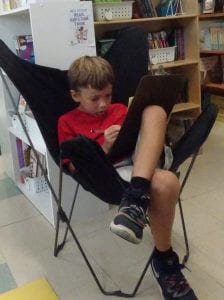 We’re enjoying School Days According to Humphrey. Humphrey is a classroom hamster. He’s in his second year in Room 26 and he can’t yet understand why he’s back, but his classmates from last year are not. At this point in the book he’s beginning to understand they are in other classrooms and that he has new students to help. Hmm…he’s got a lot to think about. You may want to
We’re enjoying School Days According to Humphrey. Humphrey is a classroom hamster. He’s in his second year in Room 26 and he can’t yet understand why he’s back, but his classmates from last year are not. At this point in the book he’s beginning to understand they are in other classrooms and that he has new students to help. Hmm…he’s got a lot to think about. You may want to 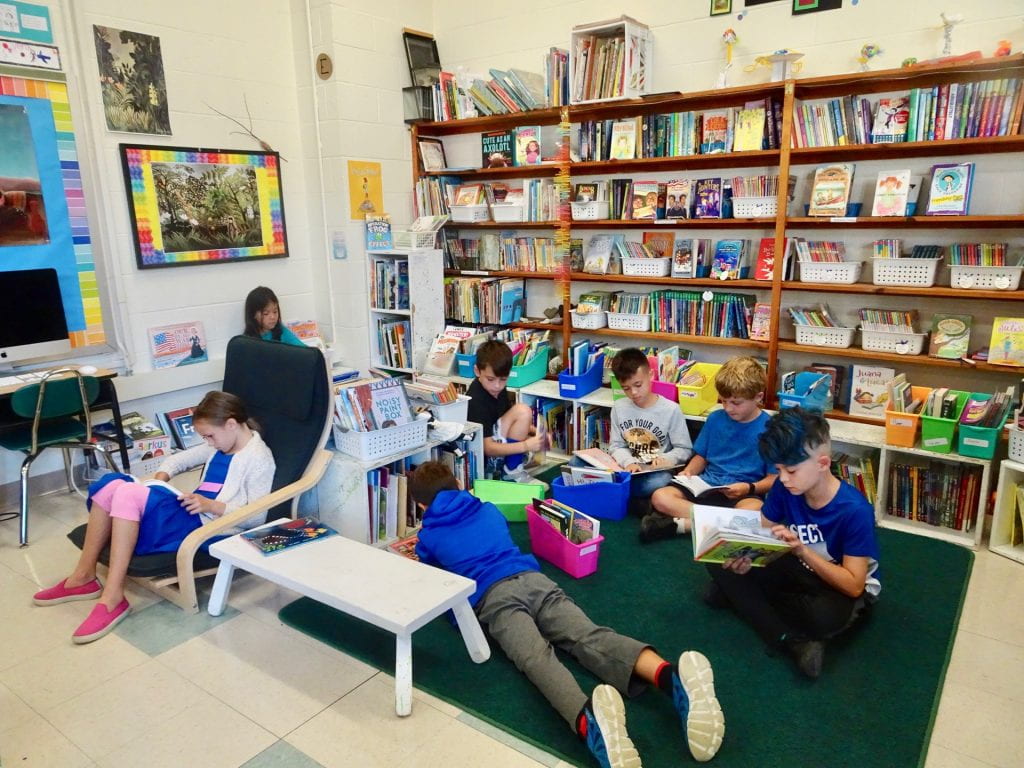
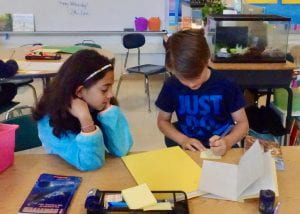 We’ve had a busy week. It began with Dot Day to celebrate working through difficulties and being kind to your self. We made our marks and now we are seeing where that takes us. (A line from the book.) On Tuesday we had picture day and then on Wednesday the children wrote letters to introduce you to some of their accomplishments so far. It was nice to meet so many of you again at curriculum night. We revised our classroom rules this week and had an assembly where we learned about school rules and expectations. Landon did a great job representing our class and presenting these new rules to the school. Thank you Landon.
We’ve had a busy week. It began with Dot Day to celebrate working through difficulties and being kind to your self. We made our marks and now we are seeing where that takes us. (A line from the book.) On Tuesday we had picture day and then on Wednesday the children wrote letters to introduce you to some of their accomplishments so far. It was nice to meet so many of you again at curriculum night. We revised our classroom rules this week and had an assembly where we learned about school rules and expectations. Landon did a great job representing our class and presenting these new rules to the school. Thank you Landon.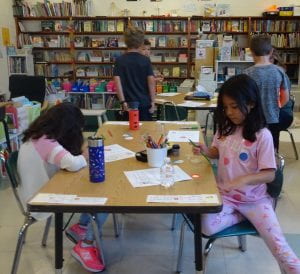 Over the last few weeks we’ve read a variety of biographies to see if we can discover the habits these famous people have that are leading them to success. We’ve read about athlete, Michael Jordan, artist, Henri Rousseau and farmer, Snowflake Bentley and scientists, Jane Goodall and Alan Rabinowitz. We discovered that no matter what their passions, they all had certain habits that helped them succeed. Here’s our list.
Over the last few weeks we’ve read a variety of biographies to see if we can discover the habits these famous people have that are leading them to success. We’ve read about athlete, Michael Jordan, artist, Henri Rousseau and farmer, Snowflake Bentley and scientists, Jane Goodall and Alan Rabinowitz. We discovered that no matter what their passions, they all had certain habits that helped them succeed. Here’s our list. We may add more to our list as we learn about other famous people next week, but for now we have a pretty good beginning. What will we learn from Margaret Hamilton, Wassily Kandinsky, Billie Jean King and Rachael Carson? How will we use what we learn to set goals for ourselves in third grade? We’ll see and share with you at our first student-led goal setting conference in late fall.
We may add more to our list as we learn about other famous people next week, but for now we have a pretty good beginning. What will we learn from Margaret Hamilton, Wassily Kandinsky, Billie Jean King and Rachael Carson? How will we use what we learn to set goals for ourselves in third grade? We’ll see and share with you at our first student-led goal setting conference in late fall.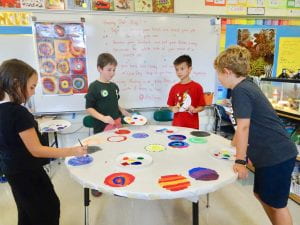 This week began to explore place value through expanded notation and base 10 riddles. The children are thinking about how groups of ones can become tens, groups of tens can become hundreds and groups of hundreds can become thousands. They have been learning about the power of ten.
This week began to explore place value through expanded notation and base 10 riddles. The children are thinking about how groups of ones can become tens, groups of tens can become hundreds and groups of hundreds can become thousands. They have been learning about the power of ten.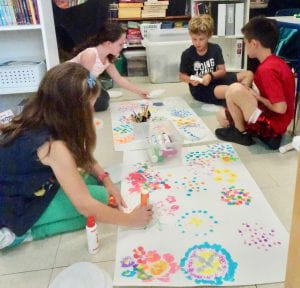 We finished reading
We finished reading 
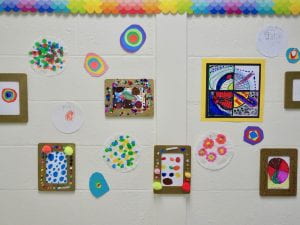
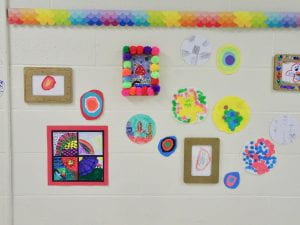

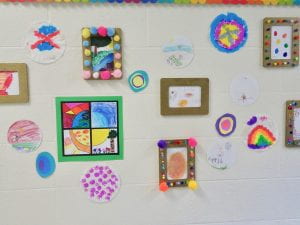

 We’ve successfully completed our first “sort-of” five-day school week, and it was a good one. We are settling into our routine. Some days have been smooth, focused and really productive. Some days have been a bit chatty and distracting, but we’ll work on that and improve. It feels as if we are developing a supportive community right from the start and that is great!
We’ve successfully completed our first “sort-of” five-day school week, and it was a good one. We are settling into our routine. Some days have been smooth, focused and really productive. Some days have been a bit chatty and distracting, but we’ll work on that and improve. It feels as if we are developing a supportive community right from the start and that is great!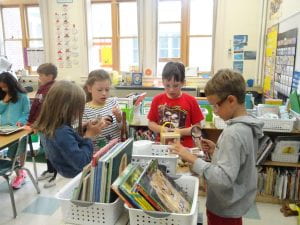 Many of our early discussions throughout these past three weeks have been about how we can help each other do the best that we can and succeed in achieving our goals. After much discussion, we decided that these would be our classroom rules. We agreed that these should be the guidelines we are attempting to meet and follow.
Many of our early discussions throughout these past three weeks have been about how we can help each other do the best that we can and succeed in achieving our goals. After much discussion, we decided that these would be our classroom rules. We agreed that these should be the guidelines we are attempting to meet and follow.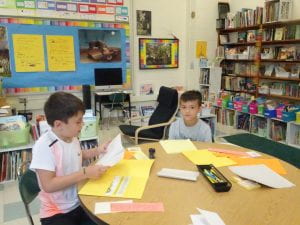 As we further define the expectations for each part of our day, we are hopeful that we will become better able to follow our guidelines more of the time. You may want to ask your child what if there is one behavior change he or she could make that would help our class be more successful in following our rules more of the time. For some of the children there will be many, but for others there will be very little. It’s just good to ask. It helps them realize their choices in the classroom and halls, in UA classes, on the playground, washing hands before lunch and in the lunchroom matter.
As we further define the expectations for each part of our day, we are hopeful that we will become better able to follow our guidelines more of the time. You may want to ask your child what if there is one behavior change he or she could make that would help our class be more successful in following our rules more of the time. For some of the children there will be many, but for others there will be very little. It’s just good to ask. It helps them realize their choices in the classroom and halls, in UA classes, on the playground, washing hands before lunch and in the lunchroom matter. Math each day starts with a warm up to get us thinking about number and amount. This week we’ve continued to review strategies for subtraction. The children are selecting three equations to solve from a grid of 12 and then they are asked to solve story problems.
Math each day starts with a warm up to get us thinking about number and amount. This week we’ve continued to review strategies for subtraction. The children are selecting three equations to solve from a grid of 12 and then they are asked to solve story problems. Just like last week, if you talk to your child about the that comes home each week, don’t be alarmed by mistakes. My comments on the problems at this point may not even help your child know if he or she has been accurate or not. I hope the comments make them think. (The children are asked to look through their work folders every morning. They aren’t reading the feedback yet.) At this point in the year, I am learning about them and their problem-solving approaches. I am coming to understand who has strong number concept and recognizes the relationships between amounts. The end goal is solving multi-step problems with accuracy and efficiency. That takes time to develop, but we’ll do it.
Just like last week, if you talk to your child about the that comes home each week, don’t be alarmed by mistakes. My comments on the problems at this point may not even help your child know if he or she has been accurate or not. I hope the comments make them think. (The children are asked to look through their work folders every morning. They aren’t reading the feedback yet.) At this point in the year, I am learning about them and their problem-solving approaches. I am coming to understand who has strong number concept and recognizes the relationships between amounts. The end goal is solving multi-step problems with accuracy and efficiency. That takes time to develop, but we’ll do it.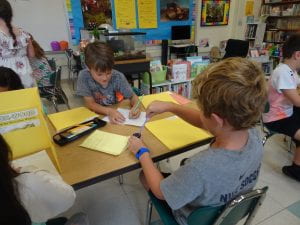 We’ve been reading about
We’ve been reading about  We are
We are  We’ve been exploring
We’ve been exploring  We’ve completed our second week and our first Friday. I hope your children feel as though we are settling into a routine. The class developed its daily jobs list. We started using it on Wednesday and it has been exciting to feed the animals and work together to get things done.
We’ve completed our second week and our first Friday. I hope your children feel as though we are settling into a routine. The class developed its daily jobs list. We started using it on Wednesday and it has been exciting to feed the animals and work together to get things done.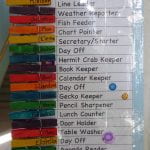 This week our focus was on what are our rights and responsibilities as members of a community. We spent time defining community – a group of people that come together to do something – and a right – something you need and should have – and responsibilities – actions we need to take to make sure members of our community can have their rights met. We’ve read several books like Swimmy, Miss Nelson is Missing and The Great Fuzz Frenzy to help us understand how communities work together and what can happen when they fall apart. We read about rights in I Have the Right to Be a Child and we’ve begun to consider how many different communities we are a part of.
This week our focus was on what are our rights and responsibilities as members of a community. We spent time defining community – a group of people that come together to do something – and a right – something you need and should have – and responsibilities – actions we need to take to make sure members of our community can have their rights met. We’ve read several books like Swimmy, Miss Nelson is Missing and The Great Fuzz Frenzy to help us understand how communities work together and what can happen when they fall apart. We read about rights in I Have the Right to Be a Child and we’ve begun to consider how many different communities we are a part of.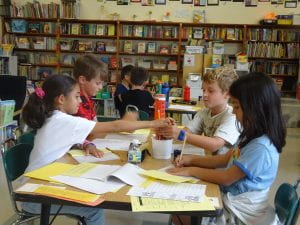 You’ll notice that several papers in the back of your child’s folder where s/he was thinking about what habits and behaviors would help us become a more successful learning community. Most of the children are hoping for a calm, focused, helpful learning community. And it is certainly true; the children are able to do their best work in that environment. It can be hard to maintain. We are beginning to see the importance of reflecting and thinking carefully about what we are doing. We are trying to consider how our choices impact one another. We are using theses ideas and discussions to develop our classroom rules and guidelines that will remind us to make better choices.
You’ll notice that several papers in the back of your child’s folder where s/he was thinking about what habits and behaviors would help us become a more successful learning community. Most of the children are hoping for a calm, focused, helpful learning community. And it is certainly true; the children are able to do their best work in that environment. It can be hard to maintain. We are beginning to see the importance of reflecting and thinking carefully about what we are doing. We are trying to consider how our choices impact one another. We are using theses ideas and discussions to develop our classroom rules and guidelines that will remind us to make better choices. This week in math we’ve reviewed different strategies for knowing and thinking about addition facts. There are 100 altogether, but when we break them down to think about the different strategies we can use to find the sum quickly it’s not so bad. We’ve learned a couple of games that help practice these facts – Roll Two Dice (a probability game) and Card Combinations for adding and Subtracting.
This week in math we’ve reviewed different strategies for knowing and thinking about addition facts. There are 100 altogether, but when we break them down to think about the different strategies we can use to find the sum quickly it’s not so bad. We’ve learned a couple of games that help practice these facts – Roll Two Dice (a probability game) and Card Combinations for adding and Subtracting.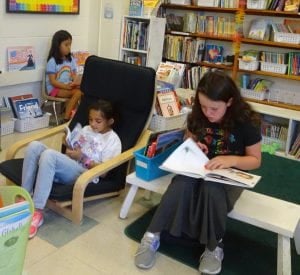 We’ve also begun exploring polygons. We read Tangled: A Story About Shapes, Friendshapes and The Greedy Triangle to remind us of how many different shapes there actually are. We’re learning about different categories of 2-dimensional shapes and how they are sorted. We’re learning about congruence, lines of symmetry and angles. We’re having fun with this as we build our calendar each day and learn more.
We’ve also begun exploring polygons. We read Tangled: A Story About Shapes, Friendshapes and The Greedy Triangle to remind us of how many different shapes there actually are. We’re learning about different categories of 2-dimensional shapes and how they are sorted. We’re learning about congruence, lines of symmetry and angles. We’re having fun with this as we build our calendar each day and learn more.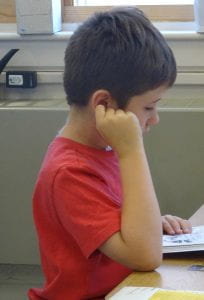
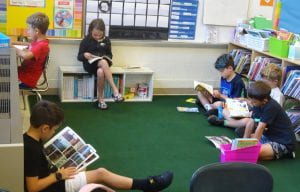
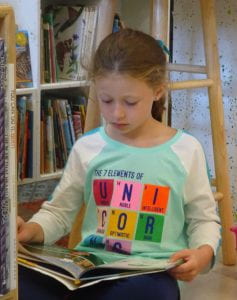
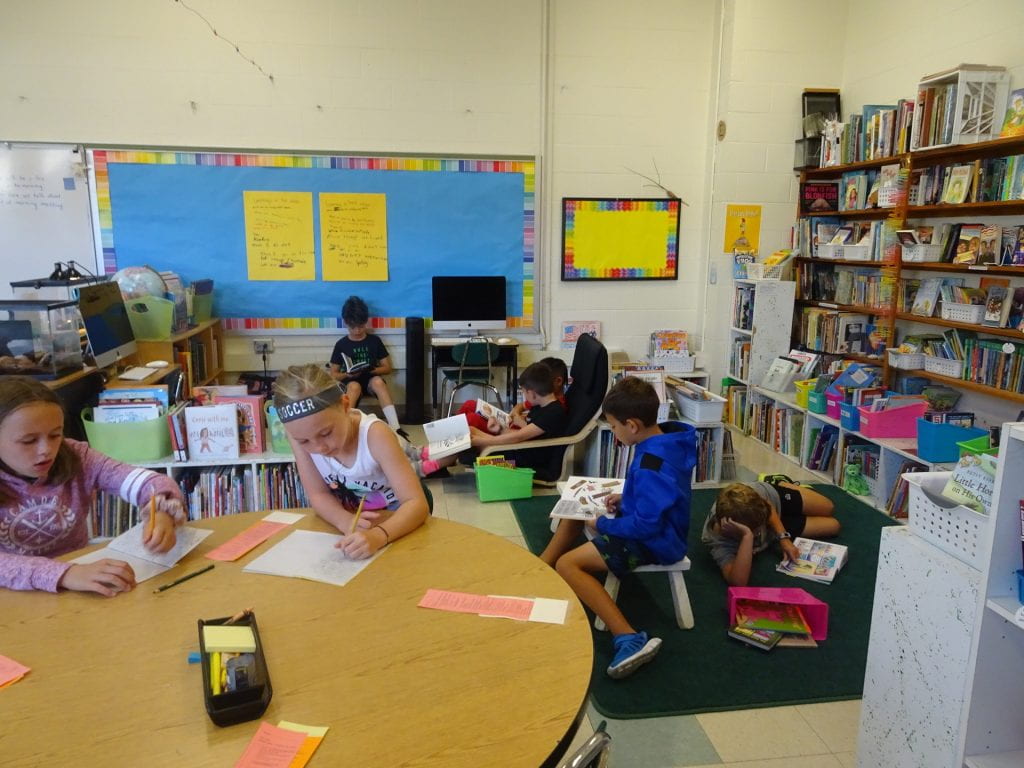 I think we’ve had a great start to our school year. I hope your children are feeling the same way. We’ve had fun getting to know each other. We’ve created two different glyphs and several different graphs. We’ve done a couple of different writing projects and we’ve shared some great books together.
I think we’ve had a great start to our school year. I hope your children are feeling the same way. We’ve had fun getting to know each other. We’ve created two different glyphs and several different graphs. We’ve done a couple of different writing projects and we’ve shared some great books together.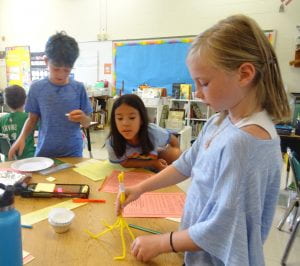 We also read some books about starting school and being new, either to the school or to the grade. After reading The Day You Begin, Unicorn Thinks He’s So Great and Unicorn Is Maybe Not So Great After All we began to realize we each have to share our stories so we can truly get to know each other. Guesses and assumptions don’t work that well. We’re realizing, the more we share the more we find what we have in common.
We also read some books about starting school and being new, either to the school or to the grade. After reading The Day You Begin, Unicorn Thinks He’s So Great and Unicorn Is Maybe Not So Great After All we began to realize we each have to share our stories so we can truly get to know each other. Guesses and assumptions don’t work that well. We’re realizing, the more we share the more we find what we have in common. This week in math we’ve been roaming the known. We’ve been reviewing two-digit addition and subtraction. We’ve created several graphs and taken an assessment to see what parts of
This week in math we’ve been roaming the known. We’ve been reviewing two-digit addition and subtraction. We’ve created several graphs and taken an assessment to see what parts of  2ndgrade math stuck. As I have reviewed the daily work, it seems to me that the children have a lot of understanding that doesn’t show. The ways the problems are worded are unfamiliar and the directions may have been confusing. As you look at your children’s work – please let mistakes go at this point in the year. We are just getting to know each other. We’ll learn how to communicate clearly in the next few weeks and then your children’s real abilities will show.
2ndgrade math stuck. As I have reviewed the daily work, it seems to me that the children have a lot of understanding that doesn’t show. The ways the problems are worded are unfamiliar and the directions may have been confusing. As you look at your children’s work – please let mistakes go at this point in the year. We are just getting to know each other. We’ll learn how to communicate clearly in the next few weeks and then your children’s real abilities will show.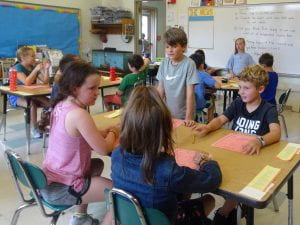 At the end of each week I will send home a letter sharing some of the things we have done throughout the week. Please look for it in the front of your communication folder. My goal is to give you some talking points so you can extend your child’s learning at home. On that same day you’ll find a similar parent letter on our blog – 3enews.edublogs.org As you can see, this one is illustrated with photographs from our classroom. Scroll down a bit, and you’ll be able to see some of the books we’ve shared in the classroom this week. That’s another thing to talk about with your child. And this time, if you scroll a bit further down, you’ll see a place where you can subscribe to get notification about postings. Please do that so you don’t miss out on any of the posts.
At the end of each week I will send home a letter sharing some of the things we have done throughout the week. Please look for it in the front of your communication folder. My goal is to give you some talking points so you can extend your child’s learning at home. On that same day you’ll find a similar parent letter on our blog – 3enews.edublogs.org As you can see, this one is illustrated with photographs from our classroom. Scroll down a bit, and you’ll be able to see some of the books we’ve shared in the classroom this week. That’s another thing to talk about with your child. And this time, if you scroll a bit further down, you’ll see a place where you can subscribe to get notification about postings. Please do that so you don’t miss out on any of the posts. Presently, last year’s students’ blogs are still up and will be for a couple of weeks. Soon, your children will be setting up their own blogs. We’ll have time each week for the children to create posts. That doesn’t mean they’ll finish one each week, but I know they’ll try. Blogging is a different type of writing and most children really like the idea of creating digital texts to share with a wider audience. Once the student blogs are up and running you can share your child’s URL with family far away and they can become more involved with this year’s activities.
Presently, last year’s students’ blogs are still up and will be for a couple of weeks. Soon, your children will be setting up their own blogs. We’ll have time each week for the children to create posts. That doesn’t mean they’ll finish one each week, but I know they’ll try. Blogging is a different type of writing and most children really like the idea of creating digital texts to share with a wider audience. Once the student blogs are up and running you can share your child’s URL with family far away and they can become more involved with this year’s activities.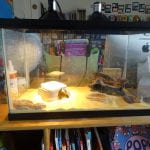
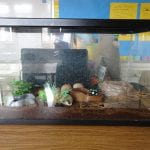
 We’re reading 8 Class Pets + 1 Squirrel ÷ 1 Dog = Chaos as our first chapter read-aloud. Ask your child what is happening in the story.
We’re reading 8 Class Pets + 1 Squirrel ÷ 1 Dog = Chaos as our first chapter read-aloud. Ask your child what is happening in the story. I wonder if you’re feeling both blue and excited like I am. I’m blue that summer is coming to an end and I’m blue that 3E is changing. I’m excited for school to be starting again and I’m wondering how our new year will unfold. We’ve still got a little bit of summer left, so let’s celebrate.
I wonder if you’re feeling both blue and excited like I am. I’m blue that summer is coming to an end and I’m blue that 3E is changing. I’m excited for school to be starting again and I’m wondering how our new year will unfold. We’ve still got a little bit of summer left, so let’s celebrate. Here are some problems to solve.
Here are some problems to solve.